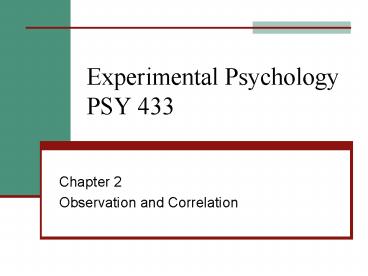Experimental Psychology PSY 433 - PowerPoint PPT Presentation
1 / 15
Title:
Experimental Psychology PSY 433
Description:
Experimental Psychology PSY 433 Author: NAlvarado Last modified by: nalvarado Created Date: 1/7/2004 6:37:03 PM Document presentation format: On-screen Show (4:3) – PowerPoint PPT presentation
Number of Views:161
Avg rating:3.0/5.0
Title: Experimental Psychology PSY 433
1
Experimental PsychologyPSY 433
- Chapter 2
- Observation and Correlation
2
Does Country Music Cause Suicide?
- http//www.youtube.com/watch?v-Xu71i89xvs
- Stack Gundlach found that metro areas that
played more country music had higher suicide
rates, concluding that country music causes
suicide. - Maybe depressed people seek out sad music?
- http//www.jstor.org/stable/2580303
3
Non-Experimental Research
- Variable -- a characteristic that can have
different values (height, weight). - Value -- usually a single, specific number (6
feet tall, 140 pounds). - Measurement the process of assigning numbers to
entities in the world. - In non-experimental research, variables may be
measured, but nothing is being manipulated by the
experimenter. - No independent variable, just DVs.
4
Naturalistic Observation
- Methods for observing behavior in its natural
environment. - Behavior is complex and humans have limited
attention span, so we delimit, or narrow, the
range of behaviors we plan to observe. - Reactivity -- subjects may behave differently
than usual when they know they are being observed.
5
Unobtrusive Observation
- Unobtrusive observation -- subject is unaware of
being observed in presence of observer - Example chivalry study, bathroom study.
- Unobtrusive measurement -- observer collects
evidence in absence of subject and infers
behavior of subject. - Example graffiti study, collecting scat
- There is a danger in anthropomorphizing or
incorrectly interpreting what is observed. - Participant observation going native
6
Survey Techniques
- Gives a picture of peoples attitudes, beliefs,
behaviors, and feelings about a topic. - Sample from a population, then infer based on
sample -- only as good as the sample. - Return rate may produce sampling problem.
- Collect large amounts of data from large number
of people quickly. - Does not show causality among variables.
- Can also be used to provide data for the
correlational method.
7
Relational Research
- Contingency Research
- Variables are presented in a contingency table.
- A Chi Square statistic is computed to determine
whether relationships among variables exist. - Values in the tables are counts or frequencies
for categories, not measurements. - Data is ex post facto
8
Correlational methods
- Correlation a statistical technique that
expresses the degree of linear relationship
between 2 variables. - If the correlation is high, a strong linear
relationship exists. - If the correlation is low, a weak relationship
exists. - If the correlation is zero, there is no
relationship.
9
Correlation Coefficient (r)
- r is a numerical index of the degree of linear
relationship between 2 variables. - r is computed by taking into account pairs of
scores one score from one variable and the
other score from another variable. - Correlation coefficient (r) has a strength (0-1)
and a direction ( or -). - r allows us to more precisely compare different
sets of variables - SAT GPA vs IQ GPA
10
Using Coefficient (r)
- Does income level predict reading level?
- Measure income level at grade 1
- Measure reading level at grade 1
- Compute correlation between reading level
income - What if r 1.0? What if r -1.0?
- What if r .88? What if r -.88?
- What if r .15? What if r -.19?
- What if r 0.0?
11
Values of r for Multiple Variables
12
Causality and Correlation
- The directionality problem -- for any correlation
between X and Y - X may cause Y
- Y may cause X
- Z may cause both X and Y
- Classic examples
- Hours watching violent TV violent behaviors ()
- Grades in physics grades in statistics ()
13
Spurious Correlations
- Spurious correlation -- a correlation exists but
no causal relationship exists. - Spurious correlations generally occur because
both variables are mediated by a third variable. - Classic examples
- Number of churches in a town and number of
murders. - Number of toasters owned in a household and
number of teen pregnancies. - Kids in private schools get higher test scores.
14
Biases
- Selection bias a kind of spurious correlation
- Students in Mississippi had a higher average SAT
than in California even though California spent
more per pupil than Mississippi. - In Mississippi only top students took the SAT
whereas in California nearly all took it. - Restriction of range -- a correlation may
underestimate the relationship between two
variables if the range of either variable is
restricted.
15
An Example of Restricted Range































